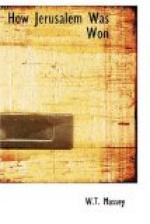Down to the south the Turks had to bring their divisions. Their line of communications was very bad. There was a railway from Aleppo through Rayak to Damascus, and onwards through Deraa (on the Hedjaz line) to Afule, Messudieh, Tul Keram, Ramleh, Junction Station to Beit Hanun, on the Gaza sector, and through Et Tineh to Beersheba. Rolling stock was short and fuel was scarce, and the enemy had short rations. When we advanced through Syria in the autumn of 1918 our transport was nobly served by motor-lorry columns which performed marvels in getting up supplies over the worst of roads. But as we went ahead we, having command of the sea, landed stores all the way up the coast, and unless the Navy had lent its helping hand we should never have got to Aleppo before the Turk cried ‘Enough.’ Every ounce of the Turks’ supplies had to be hauled over land. They managed to put ten infantry divisions and one cavalry division against us in the first three weeks, but they were not comparable in strength to our seven infantry divisions and three cavalry divisions. In rifle strength we outnumbered them by two to one, but if the enemy had been well led and properly rationed he, being on the defensive and having strong prepared positions, should have had the power to resist us more strongly. The Turkish divisions we attacked were: 3rd, 7th, 16th, 19th, 20th, 24th, 26th, 27th, 53rd, and 54th, and the 3rd Cavalry Division. The latter avoided battle, but all the infantry divisions had heavy casualties. That the moral of the Turkish Army was not high may be gathered from a very illuminating letter written by General Kress von Kressenstein, the G.O.C. of the Sinai front, to Yilderim headquarters on September 29, 1917.[1]
[Footnote 1: See Appendix IV.]
The troops who won Palestine and made it happier than it had been for four centuries were exclusively soldiers of the British Empire. There was a French detachment and an Italian detachment with General Allenby’s Army. The Italians for a short period held a small portion of the line in the Gaza sector, but did not advance with our force; the French detachment were solely employed as garrison troops. The French battleship Requin and two French destroyers cooperated with the ships of the Royal Navy in the bombardment of the coast. Our Army was truly representative of the Empire, and the units composing it gave an abiding example that in unity rested our strength. From over the Seven Seas the Empire’s sons came to illustrate the unanimity of all the King’s subjects in the prosecution of the war. English, Scottish, Irish, and Welsh divisions of good men and true fought side by side with soldiers of varying Indian races and castes. Australia’s valiant sons constituted many brigades of horse and, with New Zealand mounted regiments, became the most hardened campaigners in the Egyptian and Palestine theatre of operations. Their powerful support in the day of anxiety and trial, as well as in the time of




